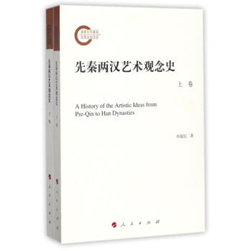
. > WHAT'S NEW > BOOKS
Rites, music and formation of artistic concepts
Author : MAO XUANGUO Source : Chinese Social Sciences Today 2017-12-19

A History of the Artistic Ideas from Pre-Qin to Han Dynasties
Author: Liu Chengji
Publisher: People’s Publishing House
Any book that made a significant theoretical contribution can attribute its success to innovation in research ideas and methods. This is the case with A History of the Artistic Ideas from Pre-Qin to Han Dynasties. The author engaged in the study of art history of the pre-Qin and Han dynasties from the perspective of history of ideas. This is because the study of the history of ideas can better embody the academic concept of “art over aesthetics.” The author also chose this area because as a pre- or sub-history of philosophy, ideological history is more prone to breaking the shackles of fixed theoretical concepts of the history of art, and reconstructing the interaction or continuous relationship between art and theory.
As a chronicler of Chinese aesthetics and art history, the author chose pre-Qin and Han dynasties because this period was a crucial time for the formation of Chinese civilization, and also the time when the Chinese art originated. It defines the starting point and founding of Chinese artistic concepts, while fully demonstrating the conceptual characteristics of the art of pre-Qin and Han dynasties. Also, the author abandons the long-standing artistic view in the Chinese history of art that put “self-discipline of beauty” at the center, forming more open and diverse values.
The book puts forward the principle of “maintaining neutrality and allowing art history to return to Chinese history to its maximum extent.” The book is also to study the history of the pre-Qin and Han dynasties and the entire history of Chinese art.
The study of the history of artistic concepts is still a groundbreaking work in China. On the one hand, from the Qin Dynasty to the modern era, Chinese have long maintained the tradition of artistic admiration, and various artistic concepts have penetrated the field of arts and philosophy. On the other hand, there is a paucity of research on the history of artistic concepts. At the same time, the author thinks that aesthetics is only one of the goals of Chinese art. Beyond beauty there is often a higher ethic and philosophical pursuit, and art eventually enters the realm of philosophy.
For example, when discussing the art of calligraphy and painting in the Han Dynasty, the author noticed the relationship between the Han Dynasty map and Chinese landscape painting, and considered it helpful to redefining the essential characteristics of this kind of painting, that is, cognition precedes aesthetics. However, the author did not stop here, he went further into the symbolic level, arguing that the extension of the ethical significance of things in Chinese society began at least during the Neolithic period. Early sacrificial vessels often contain a view of the universe of heaven and earth while performing aesthetic features, acting as a visual equivalent of some ethical and theological concepts. Moreover, the landscape paintings of later generations even fundamentally disdain the aesthetic performance in shape and colors, and take philosophical enlightenment or freehand expression as the fundamental task of art.
Ye Shengtao made Chinese fairy tales from a wilderness
Ye Shengtao (1894–1988) created the first collection of fairy tales in the history of Chinese children’s literature...
-
How northern ethnicities integrated into Chinese nation
2023-09-18
-
Mogao caves
2023-09-12
-
Mogao Grottoes as ‘a place of pilgrimage’
2023-09-12
-
Time-honored architectural traditions in China
2023-08-29
-
Disentangling the civilizational evolution of China
2023-08-28
-
AI ethics in science fiction
2023-08-23













 2011-2013 by www.cssn.cn. All Rights Reserved
2011-2013 by www.cssn.cn. All Rights Reserved